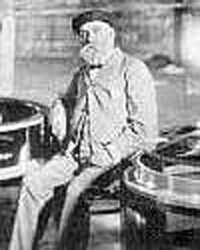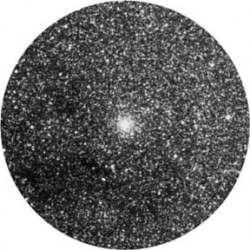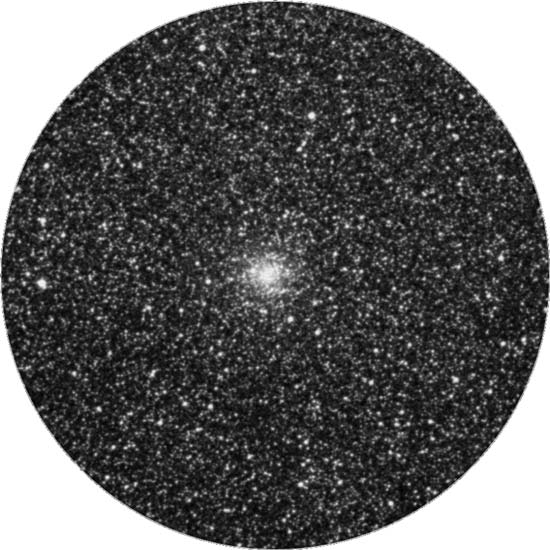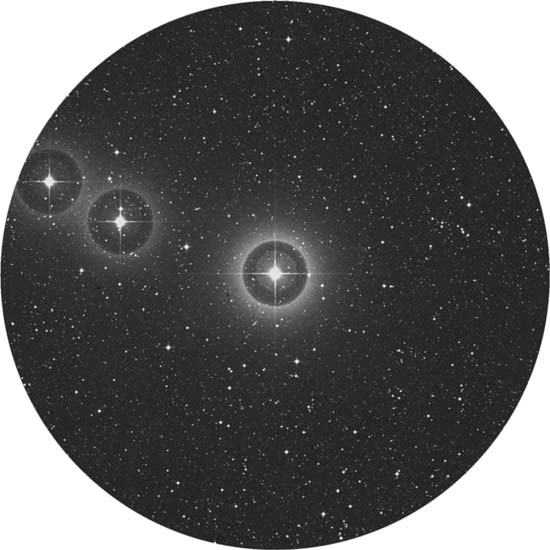Greetings, fellow SkyWatchers! Did you happen to see the close appearance of the Moon and Jupiter last night? If you thought that was fun, they’re about to get a whole lot closer tonight – and have company! With a bit darker skies this weekend, it looks like a good time to go globular and explore a few of the summer’s finest. But what weekend would be complete without a little treat? I have one in mind just for you. Follow me…
Friday, July 10, 2009 – If you’re out when the Moon rises, look for the asteroid Psyche nearly brushing the limb 0.2 degrees north. You’ll find the pairing of Jupiter and Neptune about a degree and a half apart and a little more than a finger-width south!
 Today we celebrate the 1832 birth on this date of Alvan Graham Clark. An astronomer himself, Clark was also a member of a famous American family of telescope makers. He helped to create the largest refractor in the world—the lenses for the 4000 Yerkes Telescope. Perhaps the stress of worrying for their safety took its toll on Alvan, for he died shortly after their first use.
Today we celebrate the 1832 birth on this date of Alvan Graham Clark. An astronomer himself, Clark was also a member of a famous American family of telescope makers. He helped to create the largest refractor in the world—the lenses for the 4000 Yerkes Telescope. Perhaps the stress of worrying for their safety took its toll on Alvan, for he died shortly after their first use.
Before the Moon rises tonight, let’s honor Clark’s work by studying a globular cluster suitable for all optics, M4. All you have to know is Antares! Just slightly more than a degree west (RA 16 23 35 Dec –26 31 31), this major 5th magnitude Class IX globular cluster can even be spotted unaided from a dark location. In 1746 Philippe Loys de Cheseaux happened upon this 7,200-light-year-distant beauty, one of the nearest to us. It was also included in Lacaille’s catalog as object I.9 and in Messier’s in 1764. Much to Charles’s credit, he was the first to resolve it!
As one of the loosest, or most ‘‘open’’ globular clusters, M4 would be tremendous if we were not looking at it through a heavy cloud of interstellar dust. To binoculars, it is easy to pick out a very round, diffuse patch, yet it will begin to resolve with even a small telescope. Large telescopes will also easily see a central ‘‘bar’’ of stellar concentration across M4’s core region, which was first noted by Herschel. As an object of scientific study, in 1987, the first millisecond pulsar was discovered within M4, which turned out to be ten times faster than the Crab Nebula pulsar. Photographed by the Hubble Space Telescope in 1995, M4 was found to contain white dwarf stars—the oldest in our galaxy—with a planet orbiting one of them! A little more than twice the size of Jupiter, this planet is believed to be as old as the cluster itself. At 13 billion years, it would be three times the age of the Solar System!
Saturday, July 11, 2009 – Today marks the 1732 birth on this date of Joseph Jerome Le Francais de Lalande, who determined the Moon’s parallax and published a comprehensive star catalog in 1801.
Tonight let’s head on out toward two more giants that appear differently from the rest (and each other) – same-field binocular pair M10 and M12. Located about half a fist-width west of Beta Ophiuchi, M12 (RA 16 47 14 Dec –01 56 52) is the northern most of this pair. Easily seen as two hazy round spots in binoculars, let’s go to the telescope to find out what makes M12 tick.
Since this large globular is much more loosely concentrated, smaller scopes will begin to resolve individual stars from this 24,000-light-year-distant Class IX cluster. Note that there is a slight concentration toward the core region, but for the most part the cluster appears fairly even. Large instruments will resolve out individual chains and knots of stars.
 Now let’s drop about 3.5 degrees southeast and check out Class VII M10 (RA 16 57 08 Dec –04 05 57). What a difference in structure! Although they seem to be close together and similar in size, the pair is actually separated by some 2,000 light-years. M10 is a much more concentrated globular, showing a brighter core region to even the most modest of instruments. This compression of stars is what differentiates one type of globular cluster from another and is the basis of their classification. M10 appears brighter, not because of this compression but because it is about 2,000 light-years closer than M12!
Now let’s drop about 3.5 degrees southeast and check out Class VII M10 (RA 16 57 08 Dec –04 05 57). What a difference in structure! Although they seem to be close together and similar in size, the pair is actually separated by some 2,000 light-years. M10 is a much more concentrated globular, showing a brighter core region to even the most modest of instruments. This compression of stars is what differentiates one type of globular cluster from another and is the basis of their classification. M10 appears brighter, not because of this compression but because it is about 2,000 light-years closer than M12!
Sunday, July 12, 2009 – Today marks the 1682 passing of Jean Picard. No, not he of Star Trek fame but the Jesuit astronomer who created a movable-wire micrometer to measure the diameters of celestial objects such as the Sun, Moon, and planets!
For hard-core observers, tonight’s globular cluster study will require at least a mid-aperture telescope, because we’re staying up a bit later to go for a same-low-power-field pair—NGC 6522 (RA 18 03 34 Dec –30 02 02) and NGC 6528 (RA 18 04 49 Dec –30 03 20). You will find them easily at low power just a breath northwest of Gamma Sagittarii, better known as Al Nasl, the tip of the ‘‘teapot’s’’ spout.
Once located, switch to higher power to keep the light of Gamma out of the field, and let’s do some study. The brighter, and slightly larger, of the pair to the northeast is Class VI NGC 6522. Note its level of concentration compared to the Class V NGC 6528. Both are located around 2,000 light years away from the galactic center and are seen through a very special area of the sky known as ‘‘Baade’s Window’’—one of the few areas toward our galaxy’s core region not obscured by dark dust. Although each is similar in concentration, distance, etc., NGC 6522 has a slight amount of resolution toward its edges, while NGC 6528 appears more random.
 Although both NGC 6522 and NGC 6528 were discovered by Herschel on July 24, 1784, and both are the same distance from the galactic core, they are very different. NGC 6522 has an intermediate metallicity. At its core, the red giants have been depleted, or stripped tidally by evolving into blue stragglers. It is possible that core collapse has already occurred. NGC 6528, however, contains one of the highest metal contents of any known globular cluster collected in its bulging core!
Although both NGC 6522 and NGC 6528 were discovered by Herschel on July 24, 1784, and both are the same distance from the galactic core, they are very different. NGC 6522 has an intermediate metallicity. At its core, the red giants have been depleted, or stripped tidally by evolving into blue stragglers. It is possible that core collapse has already occurred. NGC 6528, however, contains one of the highest metal contents of any known globular cluster collected in its bulging core!
Before you go, why not travel to Lupus and discover Theta, about a fist-width south-southwest of the mighty Antares (RA 16 06 35 Dec –36 48 08). Although this rather ordinary looking 4th magnitude star appears to be nothing special, there’s a lesson to be learned here. So often in our quest to look at the bright and incredible—the distant and impressive—we often forget about the beauty of a single star. When you take the time to seek the path less traveled, you just might find more than you expected. Hiding behind a veil of ‘‘ordinariness’’ is a trio of three spectral types and three magnitudes in a diamond-dust field. An undiscovered gem…
Until next week? Enjoy your beautiful starry nights when you have them. Before you turn down a chance to watch a waning July moonrise… think of how many July moon rises you may have left. Savor each moment and delight in all that’s around you. The rewards are stellar!
This week’s awesome images are (in order of appearance): Alvan Clark with Yerkes objective (historical image), M4, M12, M10, NGC 6522, NGC 6528 and Theta Lupi (credit—Palomar Observatory, courtesy of Caltech). We thank you!





